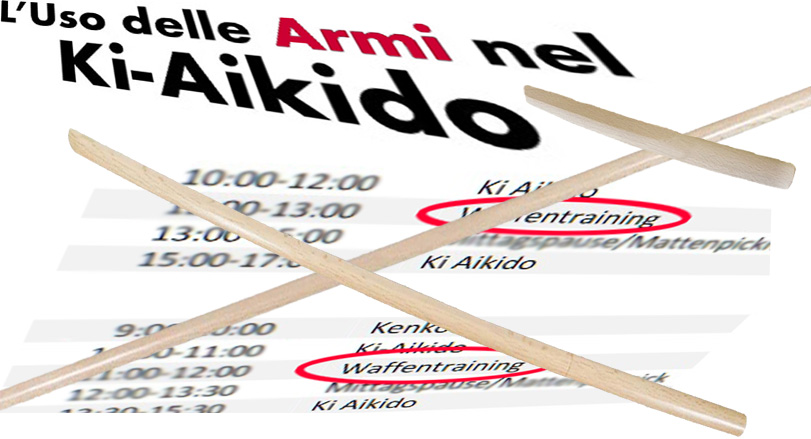I recently read the words “weapon training” and “use of weapons” on two flyers for Aikido seminars.
In view of the current heated discussions about the supply of weapons to war zones, it occurred to me whether it is good to call Bokken, Jo and Tanto, as they are used in Aikido, as weapons.
I also remembered an episode that took place at an European border before the Schengen Agreement came into force.
German Weapons Law
The German weapons law mainly deals with firearms, defines them and regulates their use.
In the appendix to the "General Administrative Regulations for the Weapons Act (WaffVwV) from March 5th 2012" there is a section that could affect Bokken, Jo and Tanto:
Appendix 1, Section 1, Subsection 2, Number 1.1
Slashing and thrusting weapons are devices that, by their very nature, are objectively intended to cause damage to health or bodily harm through direct use of muscle power through a cut, thrust, stab, punch or throw (e.g. throwing stars, spear). ...
Not cutting and thrusting weapons are those devices that are replicas of cutting and thrusting weapons (...), but because of their blunted tips and blunt edges, they are obviously only for sport (e.g. sports foil, sports epee, but not sharpened ones for mensur).
This definition obviously refers to metal objects. Since Bokken, Jo and Tanto are made of wood, they are certainly not weapons within the meaning of the law.
Yoshigasaki Sensei writes in his last book on page 155:
"You must define the meaning of each word you use and also create new words or new definitions to develop your imagination. Therefore, you have the right to define a word you use and create a new word."
If you follow this argument, then Aikidoka would be happy to call their wooden training objects weapons, but at the same time they would have to explain what they actually mean by "weapon". In any case, the use of the term can lead to misunderstandings. Outsiders might assume that Aikido actually involves working with real weapons. It is less likely that Aikidoka think they are particularly cool when they train with "weapons".
Bokken, Jo and Tanto are practiced in Aikido for historical reasons. A certain practical reference to daily life can already be found in the book “Aikido with Ki” by Maruyama and Tohei. They write: "You should be able to remain calm and composed in any situation. ... We use a knife made of wood. However, we should always view it as a real knife. This way we can learn to always remain calm, even if someone attacks us with a real sharp knife."
Nowadays it is highly unlikely that someone would attack us with a sharp sword. The Bokken techniques can therefore only serve to act on the tatami even more precisely and calmly. A bokken can also be used for defense, although an aikidoka should only aim at the arms and hands of a possible attacker. The same applies to the Jo. Most Aikidoka are probably not capable of defending against real knife attacks. You shouldn't have any misconceptions about this.
As can currently be seen with the war in Ukraine, it is not enough to control a situation once the attack has already happened. The interaction between people and states must be kept in advance in such a way that there can be no reason at all for an attack. This may sound like a pious wish, but it can definitely be achieved in everyday life.
In my numerous Aikido books, I have never found a passage that mentions "weapon training" or the "use of weapons". They talk of exercises with the Bokken, Jo or Tanto. Maybe it's better to avoid the misleading weapon terms.
B. Boll
Mensur
Use of sharp cutting weapons to develop personality.
What is the difference to Aikido?
Excerpt from Wikipedia: Mensur:
A Mensur is a traditional, strictly regulated fencing match between two male members (Pauker/paucant) of different student fraternities with sharpened bladed weapons. Since the 16th century, the term “mensur” has referred to a fixed distance between the "paucants". Mensurs are fought by many fraternities in Germany, Austria, Switzerland and a few in Belgium, Poland and the Baltics. Today the paucants are largely protected from injuries except for parts of their head and face. Any resulting wounds and their scars are called "schmisse" (smite).
Mensur fencing is neither a sport nor a duel, but it has similarities with both forms of human competition. Like sports, it's not about settling personal differences. A mensur has no winners or losers. More important than a victory is “sincere participation”, perseverance and the control of emotions.
Strong, especially dutiful fraternities see the mensur as an important aid to personality development. In preparation for this, the participant must practice a clean fighting technique (the “pauking”) and develop discipline and care in the process. He has to deal with a situation that is perceived as threatening, overcome his own fears and face it calmly.

